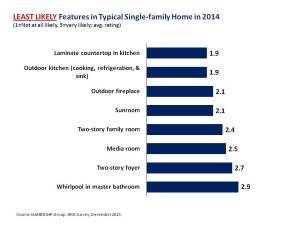Among other demographic variables, such as age, income, or stage of life, a buyer’s race or ethnicity can play a significant role in how he/she evaluates the characteristics and features of a prospective home. A new study recently released by NAHB, What Home Buyers Really Want: Ethnic Preferences, was designed to compare and contrast how housing preferences are affected– or not –by the racial/ethnic background of the home buyer, after controlling for factors such as age and income. The analysis focused on four racial/ethnic groups of buyers:
- White (Non-Hispanic),
- African-American (non-Hispanic),
- Hispanic, and
- Asian.
Survey results corroborate well-known demographic differences between these groups:
- Minority home buyers are younger than White (non-Hispanic) buyers: the median African-American buyer is 39 years old, the median Hispanic buyer is 37, and the median Asian buyer is 36. The median White buyer is 43 years old.
- Asian home buyers have the highest median household income of all four groups, $72,797, compared with $67,747 for Whites, $50,221 for Hispanics, and $43,774 for African-Americans. Asians also expect to pay the most for their next home: $283,469, compared with $205,775 among Whites, $181,444 among Hispanics, and $176,397 among African-Americans.
 So what are some of the differences/similarities among these groups in terms of housing preferences? After controlling for age, income, and household type, survey findings show that Hispanics and African-Americans want more bedrooms. In fact, 51 percent of Hispanics and 49 percent of African-Americans report wanting to have at least 4 bedrooms in their home, compared to 44 percent among Asians and 36 percent among White buyers.
So what are some of the differences/similarities among these groups in terms of housing preferences? After controlling for age, income, and household type, survey findings show that Hispanics and African-Americans want more bedrooms. In fact, 51 percent of Hispanics and 49 percent of African-Americans report wanting to have at least 4 bedrooms in their home, compared to 44 percent among Asians and 36 percent among White buyers.
 A majority of buyers in all four racial/ethnic groups, however, will be satisfied with up to 2½ baths: 73 percent of Asians, 65 percent of both White and Hispanic buyers, and 61 percent of African-Americans. Similarly, most buyers in all four groups prefer high ceilings (9 feet or more) in the first floor of their home: 75 percent of Asians, 68 percent of African-Americans, 67 percent of Hispanics, and 64 percent of White buyers.
A majority of buyers in all four racial/ethnic groups, however, will be satisfied with up to 2½ baths: 73 percent of Asians, 65 percent of both White and Hispanic buyers, and 61 percent of African-Americans. Similarly, most buyers in all four groups prefer high ceilings (9 feet or more) in the first floor of their home: 75 percent of Asians, 68 percent of African-Americans, 67 percent of Hispanics, and 64 percent of White buyers.


Placing the washer and dryer in the first floor of the home is a good bet, as buyers of all backgrounds strongly prefer this location for the laundry equipment: 76 percent of Whites, 51 percent of African-Americans, 50 percent of Hispanics, and 46 percent of Asians. The basement and garage are the second and third choice for about 20 percent of both Hispanics and Asians, significantly more than the share of White buyers who want to do laundry in either of these locations.
 The 2-car garage is the most popular parking facility across all groups, preferred by more than 50 percent of White, African-American, and Asian buyers as well as 47 percent of Hispanic buyers. A garage for 3 cars or more has far fewer fans, especially among minorities.
The 2-car garage is the most popular parking facility across all groups, preferred by more than 50 percent of White, African-American, and Asian buyers as well as 47 percent of Hispanic buyers. A garage for 3 cars or more has far fewer fans, especially among minorities.
 This blog post is the first in a series that will release findings from What Home Buyers Really Want: Ethnic Preferences, covering topics such as the specific home and community features most wanted by buyers of different racial/ethnic backgrounds.
This blog post is the first in a series that will release findings from What Home Buyers Really Want: Ethnic Preferences, covering topics such as the specific home and community features most wanted by buyers of different racial/ethnic backgrounds.





 Posted by Rose Quint
Posted by Rose Quint 






















